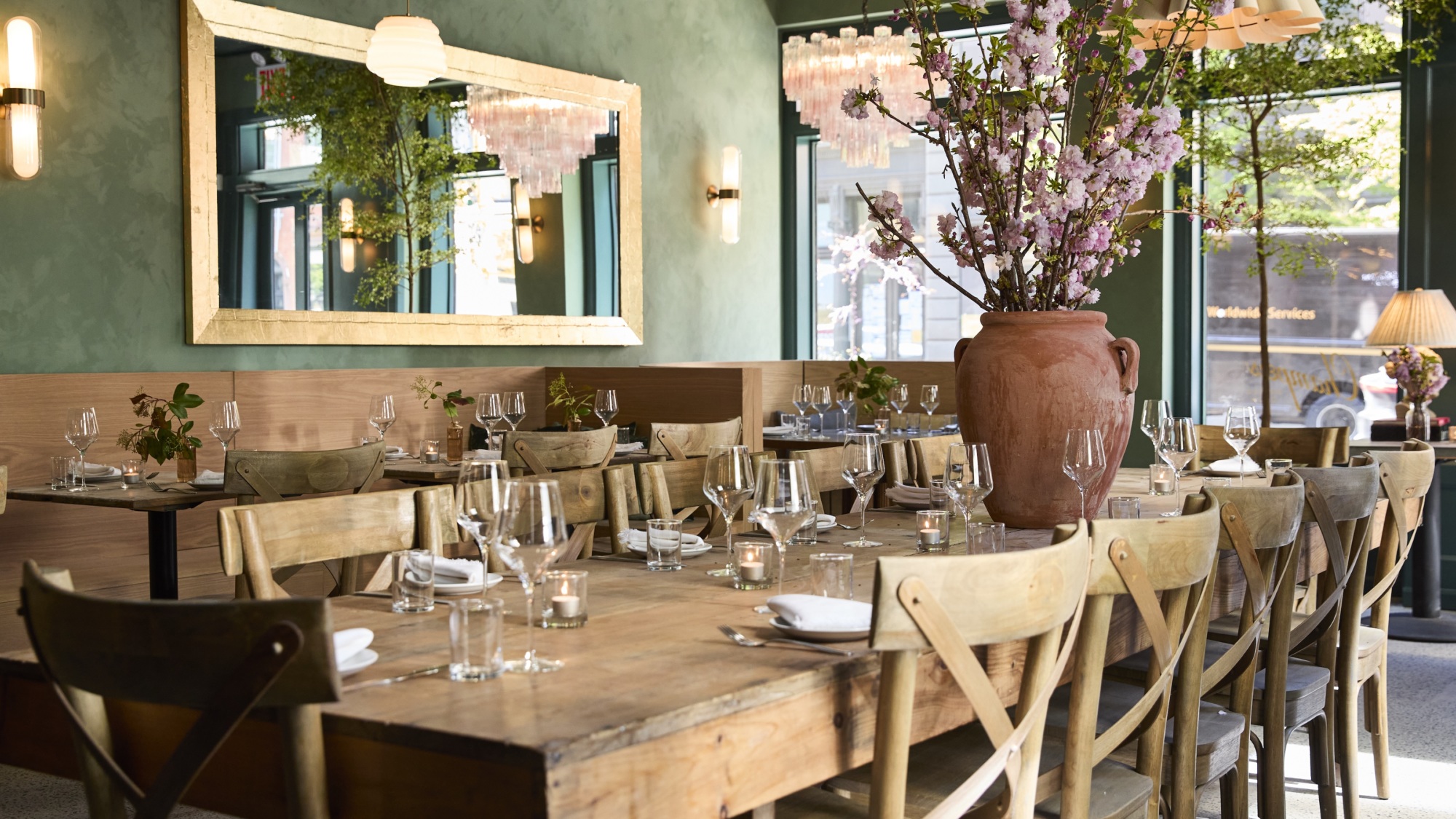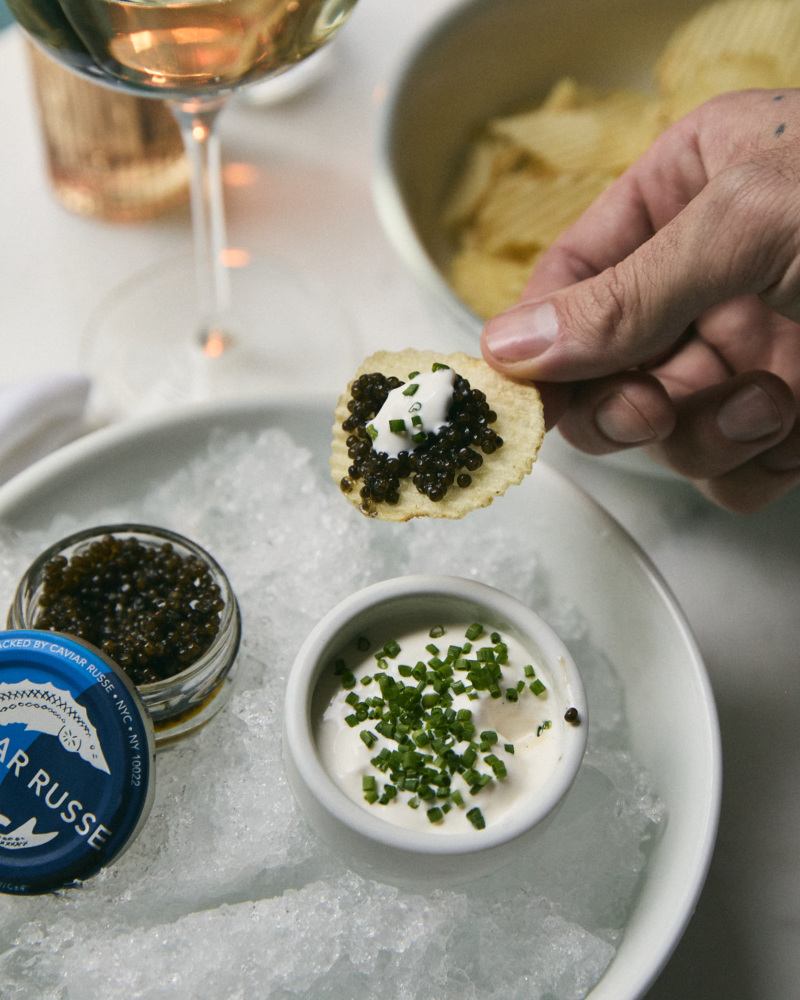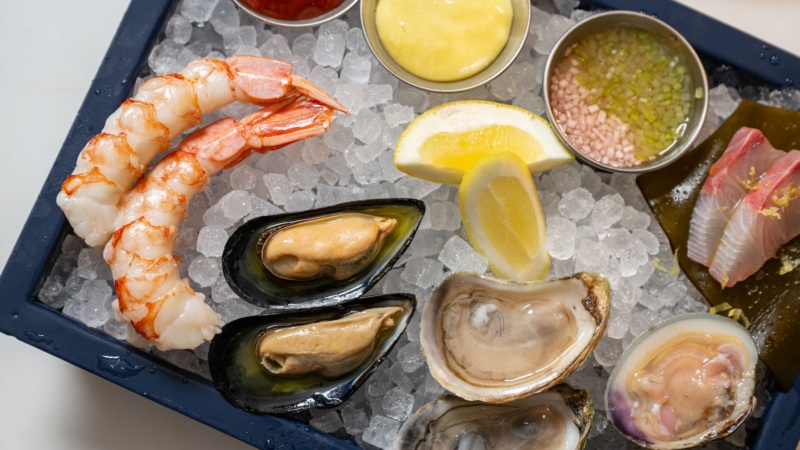
Dissecting the Highs and Lows of Dinner Party Culture at New York’s Newest Champagne Bar
Brenna Gilbert has always loved event planning — but she realizes that’s not the case for everyone.
That’s the idea behind the former retail executive’s brand Feste, which launched online this past November — making it easier for people to throw chic get-togethers of any size, for any occasion. At its core are stylishly themed party supply boxes, called “Scenes,” which are basically a hostess’ fairy godmother: elegant dishware, candles, and centerpieces, and fun extras (think palm reading cards or party horns). You can also buy items à la carte from their curated selection, or hire the Feste team to consult on or fully design your next event.
Now, the party’s on nightly in Manhattan, too. In May, Feste’s brick-and-mortar store opened in Soho and inside the store, facing Broome Street is a restaurant, Champers Social Club. The menu, by chef Connie Chung, formerly of Eleven Madison Park and the founder of Milu, a casual Chinese restaurant near Madison Square Park, subverts your expectations of a champagne bar. Sure, there are oysters and caviar, but there are also dishes that hearken back to homey, suburban parties of yore, like caramelized onion dip and pigs in a blanket. And there’s one beer on the menu: Miller High Life, naturally; the Champagne of beers.
The storefront reads, “Champagne for the people,” and that’s exactly what you’ll find: snacks both fancy and familiar, a wine list organized by vibe rather than region. We spoke to Gilbert and Chung about designing a menu with a sense of humor, democratizing Champagne, and what dinner parties offer that fine dining doesn’t.
Resy: How did the idea arise to open an actual restaurant within the Feste store/event space?
Gilbert: We wanted somewhere to gather — a place that felt like you could get together and have a good time, whether you were just having a bottle of Champagne and a bunch of oysters, or if you were doing a buyout for a full event. And we didn’t want to have a brand that was about making it easy to get together without having a place where people could actually get together. So, if we’re gonna have a party brand, we wanted to have a place people could party.
So how did Connie come into this project?
Gilbert: I always knew that I wanted to have a huge team of female leaders, and I wanted to have a chef attached to the project who would understand what the space was about: not a serious, sit-down five course menu, but really about how we wanted to entertain. And I wanted to have a New York-based female chef involved in the project. And when we were saying hey, we need somebody who has the kind of sensitivity and thoughtfulness to develop this menu, the first, and truly the only choice was Connie.
Connie, do you want to walk me through, creatively, how you devised the menu here?
Chung: The central theme was making sure the food was fun, something that you’d want to snack on and eat while you’re having a good time, and that you want to come back to. And playfulness is definitely a huge part of it. A lot of juxtaposition of luxury ingredients next to less luxurious things, like for example, the caviar served with Ruffles.
In a Champagne bar, I feel like you have to have caviar, you have to have oysters, and who doesn’t love shrimp cocktail? I actually hadn’t had shrimp cocktail in ages, until I started working on this menu with Brenna and I was like, “Man, I don’t know why I haven’t had shrimp cocktail more.” It’s just so good.
Gilbert: I think that was our only disagreement, where I was like, ‘Do you think it would be funny to put flat leaf parsley?’ And you were like, “Over my dead body are we putting flat leaf parsley.”
Chung: No no no, you wanted curly leaf parsley.
Gilbert: Oh yeah. And you were like, “No, I don’t think it’s ironic, I don’t think it’s funny.”
You do have a sense of irony and humor, with the high-low pairings like Ruffles and caviar. Which, by the way, why Ruffles and caviar?
Gilbert: The high-low is really a part of both our brand aesthetics. The way that I’ve always entertained, and the way that I’ve been brought up, is that you mix the nice things – whether it’s your grandmother’s china, whether it’s the caviar – with the things that you might already have in your closet. Something that’s always been a staple of our brand and our activations is Champagne pong – so beer pong, but with Champagne.
I think ultimately, we want to surprise and delight our guests. That’s what good hosts do: show you something you haven’t had before. And ultimately, we like the juxtaposition of those things. We like humor. We don’t take ourselves too seriously. We want to have a beautiful wine list, we want to have beautiful food, but we also want people to feel comfortable and have a good time.
Tell me about the wine list.
Gilbert: We worked very closely with Jordan Salcito, who’s the sommelier for Ramona and also an EMP [Eleven Madison Park] advisor, and we carry primarily female winemakers, or grower winemakers, vintage Champagnes. We really a focus on organic and biodiverse wines and things that pair with the food.
A lot of times you go to a Champagne bar and the Champagne list is 50 pages long. It’s enormous. It’s really hard to navigate. Our focus has been, how do we make this a more democratic approach to champagne? Champagne is something we want to drink every day. How do we help people feel comfortable navigating that? So we’ve kept the bottle list to right around 25 bottles.
Dinner party culture is, to me, nothing more than wanting to be a little more imperfect and a little more selective.— Brenna Gilbert
Why call it a ‘social club’ rather than a bar or lounge?
Gilbert: I think a traditional restaurant or bar format sometimes feels very transactional. And we really wanted this to ultimately be a flexible space. I think at the end of the day, ‘social club’ conveys a conviviality that’s very different than just a bar.
I remember, maybe seven years ago, I was a part of a membership club called Spring Street Social Society. They used to do a series of pop-up roving dinner parties in the city, and you would only find out where it was the morning of, and they were always great. It was just lovely to have something to do that was interesting and surprising and kind of caught you off guard. One of the things that I think is kind of a hallmark of our own events is that a great party also always has something that you’re doing.
There’s been a lot of talk about how fine dining is dead, how no one wants white tablecloth service anymore. Be that true or not, there’s been kind of an explosion of home entertaining, dinner party-centric concepts. Why do you think that the dinner party, or a dinner party-ish aesthetic is so big right now?
Gilbert: Yes, it’s interesting. There was that very early period on Instagram, where everyone’s Instagram was perfect, right? You had a filter, your grid looked beautiful, and everything was picture perfect. And then I think people got very tired of being perfect and were like, I’m just gonna post whatever I want. I think it’s the same thing with fine dining. I love fine dining. But I think that it is exhausting to be relentlessly perfect, and sometimes it’s really nice to have somewhere that’s more casual, more approachable.
The last few years have taught all of us about the security of home and a small group of friends. And I think that there’s something very comforting and very appealing about [that] vibe — your chosen inner circle around the table with a beautiful bowl of mussels, white wine in the middle of the table — that sounds great. Dinner party culture is, to me, nothing more than wanting to be a little more imperfect and a little more selective.
So, how do you translate the appeal of the dinner party to a restaurant or bar?
Gilbert: My favorite restaurant in New York City, RIP, was called Brucie and it was a tiny restaurant by this amazing chef. It was in Cobble Hill, and my husband and I were regulars. And by ‘regulars,’ I mean we were there five nights a week. And every night was a dinner party. Every night was a good time. I can barely remember the food, even though the food was wonderful. But I always remember how I felt there.
That’s the bridge for me between restaurants and home entertaining, is that I want people to have a good time and to remember how they felt. I would love it if they love the food and the wine, I’ve worked really hard on it. But I also really want people to have a good time and feel taken care of.
Champers Social Club is open Tuesdays through Thursdays from 11 a.m. to 10 p.m. and on Fridays through Sundays from 10 a.m. to 11 p.m.
Throughout the month of June, Resy is celebrating the Women of Food around the world, with stories devoted to the women who power the restaurant industry.
Ariana DiValentino is a writer, filmmaker, and actor based in Brooklyn. Follow her on Instagram, Twitter, and TikTok. Follow Resy, too.



























